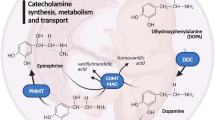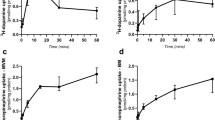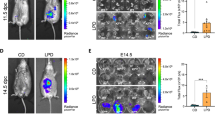Abstract
CATECHOLAMINES such as noradrenaline and adrenaline have been implicated in numerous physiological processes1–4 but, although catecholamine synthesis begins at mid-gestation5, previous studies have provided little evidence for any role in early development6,7. Furthermore, there are several case reports of humans with noradrenaline deficiency8. To investigate this, we used gene targeting9 to produce mice lacking dopamine β-hydroxylase and therefore unable to synthesize noradrenaline or adrenaline. We report here that in heterozygous mothers, most homozygous embryos died in utero, and only about 5% reached adulthood. Survival probably depends on catecholamine transfer across the placenta because, in homozygous mothers, all embryos die in utero. Mortality was due to lack of noradrenaline in utero because it could be prevented by treatment with dihydroxyphenylserine, a precursor that can be converted to noradrenaline in the absence of dopamine β-hydroxylase. Mutant embryos had a histological phenotype similar to that of embryos deficient in tyrosine hydroxylase10, suggesting that death might be due to cardiovascular failure.
This is a preview of subscription content, access via your institution
Access options
Subscribe to this journal
Receive 51 print issues and online access
$199.00 per year
only $3.90 per issue
Buy this article
- Purchase on SpringerLink
- Instant access to full article PDF
Prices may be subject to local taxes which are calculated during checkout
Similar content being viewed by others
References
Cannon, W. B. & Rosenbluth, A. Autonomic Neuroeffector Systems (Macmillan, New York, 1937).
Levi-Montalcini, R. & Angeletti, P. U. Pharmac. Rev. 18, 619–628 (1966).
Berti, F., Lentati, R. & Usardi, M. M. Med. pharmac. Exp. 13, 227–232 (1965).
Angeletti, P. U. & Levi-Montalcini, R. Proc. natn. Acad. Sci. U.S.A. 65, 114–121 (1970).
Schlumpf, M., Lichtensteiger, W., Shoemaker, W. J. & Bloom, F. E. in Biogenic Amines in Development (eds Parvez, H. & Parvez, S.) 567–590 (Elsevier North Holland Biomedical Press, Amsterdam, 1980).
Rosen, T. S., Lin, M., Spector, S. & Rosen, M. R. J. pharmac. exp. Ther. 208, 118–122 (1979).
Kudlacz, E. M., Navarro, H. A., Eylers, J. P. & Slotkin, T. A. J. dev. Physiol. 13, 243–249 (1990).
Roberts, D. et al. Hypertension 18, 1–8 (1991).
Cappechi, M. R. Science 244, 1288–1292 (1989).
Zhou, Q.-Y., Quaife, C. J. & Palmiter, R. D. Nature 374, 640–643 (1995).
Morgon, C. D., Sandier, M. & Panigel, M. Am. J. obstet. Gynecol. 112, 1068–1075 (1972).
Parvez, S. & Parvez, H. Hormone Res. 5, 321–330 (1974).
Kato, T., Karai, N., Katsuyama, M., Nakamura, M. & Katsube, J. Biochem. Pharmac. 36, 3051–3057 (1987).
Jones, C. T. & Robinson, R. O. J. Physiol. 248, 15–33 (1975).
Seidler, F. J. & Slotkin, T. A. J. Physiol. 358, 1–16 (1985).
Baldessarini, R. J. J. Neurochem. 18, 2509–2518 (1971).
David, J. C., Cavoy, A., Coulon, J. F. & Delacour, J. Neuroscience 12, 1271–1276 (1984).
Theiler, K. The House Mouse: Atlas of Embryonic Development (Springer, New York, 1989).
Liebmann, J. E. & Matsumoto, A. M. Endocrinology 126, 555 (1990).
Author information
Authors and Affiliations
Rights and permissions
About this article
Cite this article
Thomas, S., Matsumoto, A. & Palmiter, R. Noradrenaline is essential for mouse fetal development. Nature 374, 643–646 (1995). https://doi.org/10.1038/374643a0
Received:
Accepted:
Issue date:
DOI: https://doi.org/10.1038/374643a0
This article is cited by
-
Intrinsic cardiac adrenergic cells contribute to LPS-induced myocardial dysfunction
Communications Biology (2022)
-
Functional characterization of dopamine and norepinephrine transport across the apical and basal plasma membranes of the human placental syncytiotrophoblast
Scientific Reports (2022)
-
Recent Computational Insights into the Oxygen Activation by Copper-Dependent Metalloenzymes
Topics in Catalysis (2022)
-
Co-released norepinephrine and galanin act on different timescales to promote stress-induced anxiety-like behavior
Neuropsychopharmacology (2021)
-
Insights into the expanding phenotypic spectrum of inherited disorders of biogenic amines
Nature Communications (2021)



